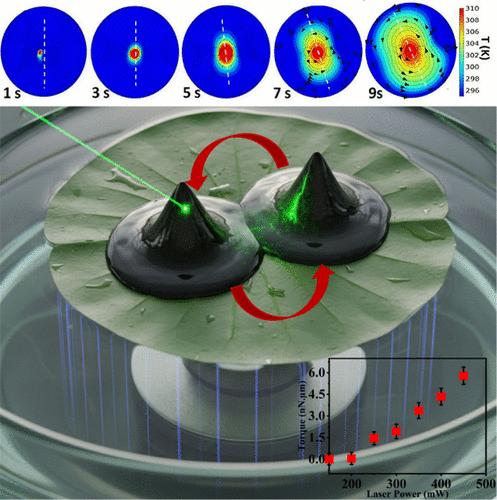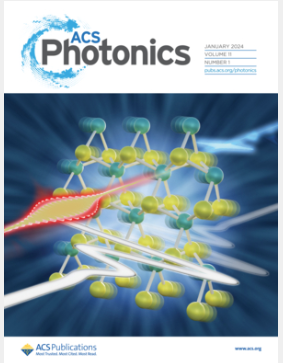通过光热诱导纳米流体组装铁流体动力学的磁光驱动宏观物体的旋转动力学
IF 6.7
1区 物理与天体物理
Q1 MATERIALS SCIENCE, MULTIDISCIPLINARY
引用次数: 0
摘要
在流体环境中使用微和纳米游泳器对大型宏观物体进行远程操作,在机器人技术中具有重要的潜力。传统的基于光产生的角动量或光与物质相互作用产生的反冲力的分子或微系统的光学控制受到电磁场产生的力的限制。利用激光诱导的铁磁流体微液滴热磁力梯度,开发了一种新的光机械系统,以产生更大的扭矩,使宏观物体沿任何所需轴的可控旋转成为可能。这种独特的机制利用了由空间局域激光诱导的光热效应控制的磁形成的铁磁流体微滴域的扭转运动。铁磁流体体积内的微液滴与具有广泛表面的宏观物体耦合,允许在不需要机械致动器的情况下在水面上进行较重有效载荷的光学旋转。通过调整激光的位置,可以将旋转方向从顺时针方向切换到逆时针方向。角速度可以通过激光强度调节,并取决于物体的质量。实验结果表明,当激光功率为300 mW时,可获得6 nN·μm的大扭矩,最大携带-自重比接近被捕获液滴重量的140倍。它为遥控机器人和流体操纵开辟了新的途径,允许在各种环境中更有效和通用的宏观物体控制。本文章由计算机程序翻译,如有差异,请以英文原文为准。

Rotational Dynamics of Magneto-optically Driven Macroscopic Objects through Photothermally Induced Ferrohydrodynamics of Nanofluid Assembly
The remote manipulation of large macroscopic objects using micro- and nanoswimmers in fluidic environments offers significant potential in robotics. Conventional optical control of molecules or microsystems based on light-generated angular momentum or recoil force from light–matter interaction is limited by the force generated by an electromagnetic field. A novel optomechanical system utilizing a laser-induced thermomagnetic force gradient in ferrofluidic microdroplets is developed to generate a larger torque, enabling the controlled rotation of macroscopic objects along any desired axis. This unique mechanism leverages the torsional motion of magnetically formed ferrofluidic liquid microdroplet domains controlled by spatially localized laser-induced photothermal effects. The microdroplets within the ferrofluid volume are coupled to macroscopic objects with extensive surfaces, allowing for the optical rotation of heavier payloads on the water surface without the need for mechanical actuators. The rotational direction can be switched from clockwise to counterclockwise by adjusting the laser’s position. Angular velocity is adjustable through laser intensity and depends on the object’s mass. Experimental results show that a giant torque of 6 nN·μm can be achieved with a 300 mW laser power, and the maximum carry-to-self-weight ratio approaches 140 times the weight of the droplet being trapped. It opens new avenues for remote-controlled robotics and fluidic manipulation, allowing for more efficient and versatile control of macroscopic objects in various environments.
求助全文
通过发布文献求助,成功后即可免费获取论文全文。
去求助
来源期刊

ACS Photonics
NANOSCIENCE & NANOTECHNOLOGY-MATERIALS SCIENCE, MULTIDISCIPLINARY
CiteScore
11.90
自引率
5.70%
发文量
438
审稿时长
2.3 months
期刊介绍:
Published as soon as accepted and summarized in monthly issues, ACS Photonics will publish Research Articles, Letters, Perspectives, and Reviews, to encompass the full scope of published research in this field.
 求助内容:
求助内容: 应助结果提醒方式:
应助结果提醒方式:


